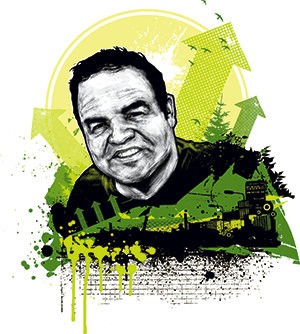Cafe Magazine
April 20, 2010

By Darhiana Mateo
Artists. Innovators. Advocates. Grassroots Warriors. These are the new brown faces of the green movement. During a time when environmental issues are still not viewed as a priority for people of color, this group of fearless Latino leaders from across the country and representing various sectors, are proof that we not only get the message, we’re leading the way.
From mobilizing Latino communities through grassroots efforts to pioneering new solutions for energy storage to raising awareness through art installations in the Earth’s polar caps, these activists are channeling their talents into making our home planet a better place for all of us.
THE ECO-ARTIST
The son of Cuban exiles, Miami “eco-artist” Xavier Cortada blurs the line between art and activism.
Surrounded by the beauty of the Florida Keys and Everglades, Cortada, 45, recalls being as fascinated by their splendor as he was by the art world. “As a kid from an exile immigrant family, the thing that grounded you was nature,” he says. “The same way my family shared stories about family members, they shared stories about floral and fauna in the homeland.”
The family also passed down an appreciation for the arts. “Art is something that has always been intuitive and natural to me,” he says, recalling a colorful childhood rich with festivals, dances and theater.
latino5Still, it would not be until much later that Cortada would merge his two passions – art and nature – into a career as an artist/activist. While attending the University of Miami, he would switch majors countless times, from biology to English to religion, only to end up going to law school (never mind all those law school notebooks covered in doodles).
The man with the mind of a scientist and soul of an artist would shelve both passions to work as a community organizer around social justice issues. Later, he was invited to join the University of Miami faculty and would travel Latin America and Africa lecturing on community organizing. It was while visiting South Africa that he would find his calling.
“The kids couldn’t speak Spanish or English, so I started using art as a visual aid to communicate,” Cortada says. “That’s when I realized that art is a really powerful tool as this universal language. It allowed me to engage people to effectuate social change.”
These days, he is part of a small but growing wave of artists who identify themselves as eco-artists and use their work to raise awareness and urge the global community to take action.
Cortada has recently garnered a lot of buzz for his art installations at the North and South poles as an attempt to generate awareness about global climate change. In 2008, he planted a green flag at the North Pole to “reclaim it for nature” while protesting global deforestation by encouraging people to plant a native tree next to a green flag at home. The symbolism behind the “Native Flags” installation is powerful, says Cortada. “You are taking this thing used to conquer and appropriating this symbol of political power and using it to give voice to the most powerless, fragile of species.”
Through his “Longitudinal Installation” in 2007, Xavier placed 24 pairs of shoes in a circle around the North and South poles, each pair representing a person living in a different part of the world affected by global climate change. The shoes were placed next to each other in their respective longitudes as a proxy for people in the world below in an attempt to “diminish the distance” between the people.
“The message is that we are all responsible. We are all stewards of this planet. To assume the problem is too big for an individual is the wrong assumption,” he says. “I create installations that make you look at the problem in a global way.”
Back in the States, Cortada is showcasing another installation, “Endangered World,” at the Biscayne National Park in Florida. The installation consists of 360 brightly colored flags – each representing one degree of the planet’s longitude. And once again, there’s the community action part: As part of the art project, individuals and organizations have adopted an endangered or threatened animal that lives at that longitude and paint an image of that animal on one of the flags. At the same time, the participants pledged to take an “eco-action” that would somehow help that endangered animal.
The kind of activism exemplified in Cortada’s body of work has a long rich history in art, says Dr. Mary Jo Aagerstoun, art historian and president of the South Florida Environmental Arts Project who is working closely with Cortada on the installation. Although the art world currently rejects art that engages the community in a very direct, interventional way as “real art,” Aagerstoun says the opposite is true.
“Art really is a part of life,” she says. “It shouldn’t be hidden away in white galleries and dead museums. It’s alive and active. I certainly think Xavier’s [work] is a good example of that.”